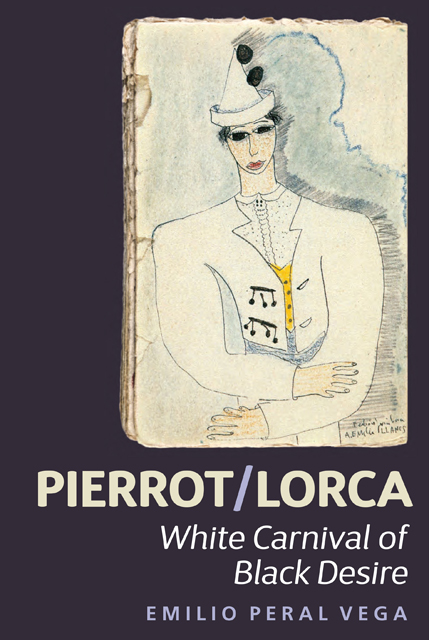Book contents
- Frontmatter
- Dedication
- Contents
- List of Illustrations
- Acknowledgements
- Prologue
- 1 A Modern Mask: From Deburau to The Tramp
- 2 First Examples of an Effeminate Pierrot: From Verlaine to Lorca
- 3 Pierrot/Lorca: Alter Ego for a Young Poet
- 4 Lorca/Pierrot: Between Painting and Theatre
- 5 Love Game and Masquerade: Dalí/Lorca
- 6 Perlimplín/Lorca/Pierrot: Frustrated Desire
- 7 A White Clown for a Black Desire: El público and Así que pasen cinco años
- Epilogue
- Bibliography
- Index
3 - Pierrot/Lorca: Alter Ego for a Young Poet
Published online by Cambridge University Press: 22 February 2023
- Frontmatter
- Dedication
- Contents
- List of Illustrations
- Acknowledgements
- Prologue
- 1 A Modern Mask: From Deburau to The Tramp
- 2 First Examples of an Effeminate Pierrot: From Verlaine to Lorca
- 3 Pierrot/Lorca: Alter Ego for a Young Poet
- 4 Lorca/Pierrot: Between Painting and Theatre
- 5 Love Game and Masquerade: Dalí/Lorca
- 6 Perlimplín/Lorca/Pierrot: Frustrated Desire
- 7 A White Clown for a Black Desire: El público and Así que pasen cinco años
- Epilogue
- Bibliography
- Index
Summary
Our starting point is a prose piece entitled ‘Pierrot’, dated 9 March 1918, and published in Prosa inédita de juventud (García Lorca, 1996b). Lorca created an adolescent Pierrot of ambiguous sexuality – thus his oblique comparison to Ganymede – in which to reflect himself. This is a Pierrot who, while walking the streets, puts make-up on his face as a means of protecting himself from the attacks of the other, represented by a disembodied ‘coro de risas’ who inflict cruel derision on him. His mask is, as a consequence, a means of hiding his own self. The identification between mask and poet becomes complete by means of a clear pronoun that accepts the intrinsic falseness of both: ‘Yo soy una máscara eterna.’ Ultimately, ‘Pierrot. Poema íntimo’ is captivating, given the early clarity of insight with regard to the use of theatrical duality, such that the poet, who is identified from the start of the text with the Pierrot mask, is able to abandon it and become an observer of the actions of his disguise in a game with two voices expressed through various literary forms: yo is poetry, él is pantomime, both condensed as two sides of the same coin into a single ending: ‘¡Pobre Pierrot! ¡Pobre máscara de mi corazón…! ¡Ay, ¡qué triste es toda la humanidad!’ [my italics].
We must analyse the text in detail, since it is the first evidence of an identification that Lorca will often use, and also given that it is an early manifestation that still lacks a clear personal aesthetic voice, which establishes a fertile array of literary relations that we will attempt to explore in the following pages. Lorca metamorphoses into a Pierrot who speaks to the reader in the first person and presents the tale through the idiom of the ‘fable’, in another mechanism for disguising his intimate truth: ‘Una historia de ensueño eterno que nunca tendrá fin’ (1996b: 416). From the start, the poet-character makes his melancholic spirit dependent on the impossibility of consummating desire: ‘Voy queriendo llegar a la cumbre del beso pero no lo consigo. Siempre encuentro obstáculos y pierdo el sendero’ (416).
- Type
- Chapter
- Information
- Pierrot/LorcaWhite Carnival of Black Desire, pp. 43 - 60Publisher: Boydell & BrewerPrint publication year: 2015

